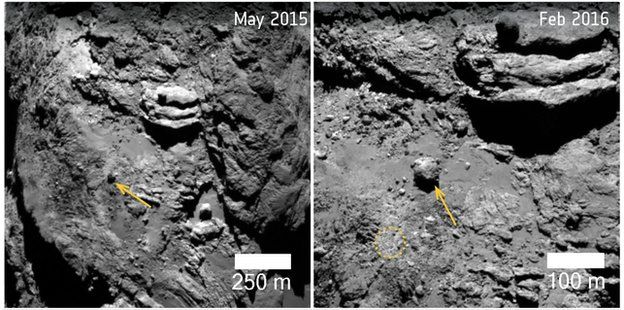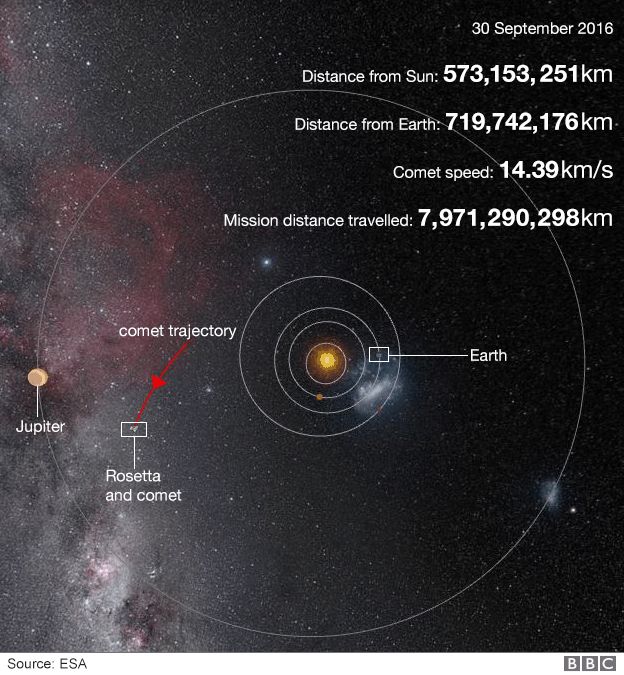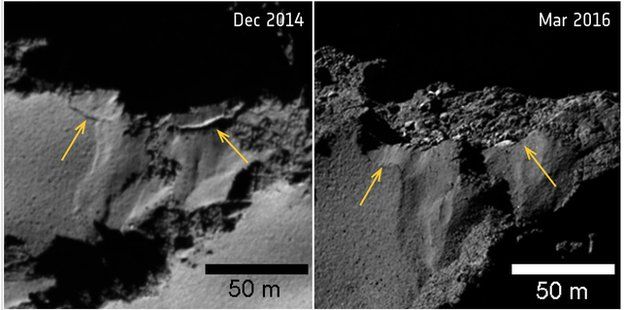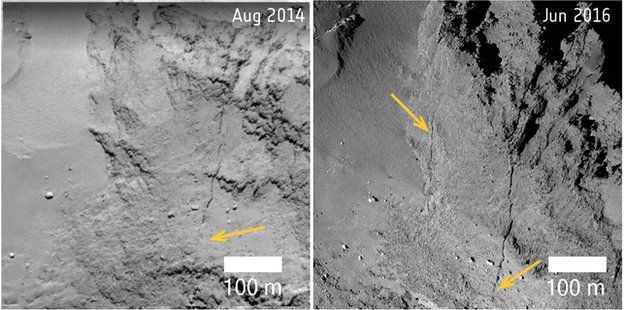Mythopoeika
I am a meat popsicle
- Joined
- Sep 18, 2001
- Messages
- 53,369
- Location
- Inside a starship, watching puny humans from afar
^Alien spacecraft ^
Farewell, Rosetta: space mission to end on collision course with comet
After a two-year journey that has shaped our understanding of the solar system, the orbiter is to be crashed into Comet 67P
Image of Comet 67P/Churyumov-Gerasimenko and its coma, taken by the Rosetta orbiter from a distance of just over 100 miles. Photograph: ESA
Robin McKie Science Editor
Sunday 11 September 2016 00.05 BST
In a few days, European Space Agency controllers will order their Rosetta space probe to make an orbital correction that will send the craft on a collision course with the comet it has been circling for more than two years.
The manoeuvre will end one of the most successful space missions ever undertaken and will give scientists a final chance to examine a comet up close and personal.
Rosetta, which cost more than £750m to build and launch, has been orbiting Comet 67P/Churyumov-Gerasimenko, a massive ball of ice, dust and organic materials, since 2014. Like other comets, 67P is thought to be made of material left over from the creation of the solar system billions of years ago – hence astronomers’ interest in it.
“Rosetta has returned reams of data we are only beginning to analyse,” said Mark McCaughrean, a senior science adviser at ESA. “It is transforming our understanding of the way the solar system was put together.”
Royal Astronomical Society president John Zarnecki, who played a key role in designing the probe more than 25 years ago, said: “Per head, Europeans pay much less than Americans do for their space science. Yet with Rosetta we have set the gold standard for comet research. In 20 years, scientists will still be doing PhDs using data from Rosetta.”
The probe was launched from Kourou in French Guiana in March 2004, on a trajectory that involved three fly-bys of Earth and one of Mars on its route to Comet 67P. The probe reached its target in August 2014, revealing the comet, which circles the sun every 6.5 years, as a strange twin-lobed object covered with craters, hills and cliffs. Three months later, Rosetta dropped a tiny lander craft called Philae on to the comet’s surface, which was found to be made of hard ice covered by a thick layer of dust in which organic chemicals could be detected. Philae also provided crucial data about the comet’s structure, which was shown to be highly porous.
“Comet 67P is amazingly light as a result of all these cavities,” said Open University geologist Natalie Starkey. “It is like a big lump of pumice that measures 3km by 5km. If you dropped it in the sea, it would float.”
Philae stopped transmitting on 15 November but Rosetta continued to orbit and study 67P as it made its closest approach to the sun last year, analysing the plumes of dust and water vapour that erupted from the comet’s surface.
A key Rosetta mission target was to search for evidence that the Earth’s oceans might be made of water brought to our planet by comets. Many scientists say Earth would have been so hot during its formation that all water would have been driven off its surface. Later – once it had cooled, it was argued – water was brought here by bombardments of comets.
FacebookTwitterPinterest
An artist’s impression of the Philae lander on the surface of the comet. Photograph: ESA/PA
But by studying the atoms of hydrogen and its isotope deuterium found in ice on 67P, Rosetta showed that the comet’s hydrogen-deuterium ratio is significantly different from that found in the water of the Earth’s oceans. “We have to conclude that Earth’s water did not come from comets like 67P. That is a key early outcome of the Rosetta mission,” said Starkey. “It means we will need to search elsewhere in the solar system, possibly on asteroids, to find the source of the water that makes up our oceans.”
By contrast, Rosetta’s discovery on 67P of organic molecules – including the amino acid glycine, commonly found in proteins, and phosphorus, a key component of DNA and cell membranes – does back the idea, which Rosetta was also designed to test, that material from comets could have played a key role in the early appearance of life on Earth.
Now Comet 67P is heading back into deep space, with Rosetta still in orbit – though the power supplied by its solar panels is rapidly dwindling as it gets further from the sun.
“We faced a choice,” said McCaughrean. “We could put the craft into hibernation, as we did between 2011 and 2014, when Rosetta was travelling through deep space towards 67P. Then, once the comet was back near the sun, we could try to reactivate it. However, the probe is getting old after two years of operation near a comet and is now covered in dust. We felt there was a real risk it wouldn’t wake up again. So the mission team decided this would be the end.”
A special target has been selected for Rosetta’s last mission, however: a region of holes, or active pits, on the comet’s “head” (the smaller of its two lobes). Jets of dust and vapour have been seen pouring from these during the comet’s closest approach to the sun. “The heat of the sun, spreading through the comet, warms underground deposits of carbon dioxide and carbon monoxide ice,” said McCaughrean.
“These deposits then evaporate, leaving caverns whose roofs collapse. Inside them, you can see features we call goosebumps or dragon’s eggs that could be primordial objects from which the comet formed. So we’re taking Rosetta down to study these.”
The beginning of the end for the craft will come in a matter of weeks, on 29 September, when controllers will manoeuvre Rosetta 20km above the active pits and point it downwards. “We will go down very slowly, under a metre a second, so we can take as many high-resolution pictures and spectrographic measurements as possible,” he said. “With luck we will get some very interesting data.”
When Rosetta hits the surface, its antenna will not be able to point at Earth and the craft will be switched off. “That will be the end of Rosetta,” said McCaughrean. “It will be an emotional moment. This has been a wonderful mission and a great team effort.”
Rosetta saw cliffs collapse on comet
By Paul RinconScience editor, BBC News website, The Woodlands, Texas
Share
- 21 March 2017
- From the sectionScience & Environment
Image copyrightESA/ROSETTA/NAVCAM
Image captionA wide range of changes were observed on Comet 67P
The comet visited by the Rosetta spacecraft is constantly being re-shaped, sometimes in dramatic fashion.
It witnessed the collapse of entire cliffs at two locations on Comet 67P, events that were probably driven by exposure to sunlight.
The European probe documented the widespread breakdown of materials on the surface during nearly two years orbiting the 4km-wide body.
Details were presented at the Lunar and Planetary Science Conference (LPSC).
Image copyrightESA/ROSETTA/MPS FOR OSIRIS TEAM
Image captionA huge boulder was seen to shift its position
Rosetta entered orbit around Comet 67P/Churyumov-Gerasimenko, to give its full name, in September 2014.
The mission enabled researchers to capture multiple images of the comet's surface features over time, to study how it changed.
"This is the first mission where we've been able to have such a huge dataset of high-resolution images, but at the same time had a long mission to a comet to study it and see how it evolves through more than two years as it journeyed through the inner Solar System," said lead author Mohamed El-Maarry, from the University of Colorado, Boulder.
Repeated heating and cooling can tease the surface materials apart, leading to erosion, say the researchers.
Dr El-Maarry and colleagues observed cliff collapses at two regions on the comet called Ash and Seth. These collapses occurred as pre-existing fractures gave way, causing sections of material tens of metres long to crumble.
In 67P's Khonsu region, a massive boulder was seen to move a distance of 140m. This could have been caused by erosion of the sloped surface the boulder was sitting on, causing it to roll. But the hefty rock could also have been moved by an outburst of dust and gas from within the comet, says the team.

Image captionEnd of mission: Rosetta was deactivated as the comet headed out towards Jupiter
At another location in the Anubis region, a steep slope retreated at a rate of 5.4m each day.
The authors note that most changes - including the erosion and the movement of boulders - occurred around perihelion, when Comet 67P was at the point in its orbital path closest to the Sun.
This suggests the events were driven by shifting patterns of exposure to sunlight.
Image copyrightESA/ROSETTA/MPS FOR OSIRIS TEAM
Image captionAsh collapse: Yellow arrows mark the fractures where the detachment occurred
However, some of the changes were unrelated to this. In the "neck" region, which connects the two large lobes of the duck-shaped comet, a huge fracture, estimated to be more than 500m in length, extended by at least another 30m. This change is thought to be connected to an increase in the comet's spinning rate.
"We see a lot of changes, but most of those are localised," said Dr El-Maarry. "We didn't get fireworks and comets splitting and massive depressions being created. We didn't see major changes in the comet's landscape. It means we had more activity earlier in the comet's lifetime."
Comet 67P was discovered in 1969 by the Soviet astronomers Klim Churyumov and Svetlana Gerasimenko, after whom it is named.
Rosetta was dumped on the surface of the icy dirt-ball in September last year and deactivated.
The LPSC runs from 20-24 March in the Woodlands, Texas. As well as reporting the 67P observations at the meeting, Mohamed El-Marry and colleagues have written up a report for the journal Science.
A companion paper on surface changes was timed for simultaneous release in the journal Nature Astronomy. Authored by Maurizio Pajola and colleagues, this study concentrated on the circumstances surrounding the collapse of a cliff called Aswan.

Image captionCrack propagation was thought to be linked to the comet's increasing spin rate
Follow Paul on Twitter
It may have stemmed from the biblical reference to a bitter star called Wormwood, which would cause disease throughout the land (or some such half-remembered vagueness).I remember reading that centuries ago, the kind of a European? country had died, and at the time the belief that comets caused diseases was so strong, when the king's death was announced to the public, it was said that he had died from consumption and from "the comet."
When I read that I did not make a note of the source and have not since been able to find the story again.
I mentioned to one of my friends that there was a lot of folklore surrounding comets, such as the belief that a kind had died from "consumption and the comet," and he replied, "you are engagint in semantics."
That was a really baffling thing for him to say.
What did he think I should have said?
That there are a lot of illogical, superstitious, and unfounded beliefs about coments?
I thought it was simpler to save un-necessary words, and just simply say that there was much folklore about comets.
Maybe he thought I was being pretentious by using the word, "folklore?"
Was he as illogical in his thinking as the people who have illogical beliefs about comets?
I'm glad that we do have a special thread on comets, and this one is so long and the pages are so long, it will take a lot of catching up to see what all has been posted to this thread.
It does look different from the surrounding stars and a lot like other photos I have seen so I think you got it.
I have been trying but it has been rather cloudy. I will keep trying though!
Filthy weather here last night but even though peak brightness was supposed to be last night, it should be possible to see throughout February so plenty more chances.
Well, to be pedantic isn't it a meteorite as it's landed?That's a green meteor. Different thing.
That's a green meteor. Different thing.


